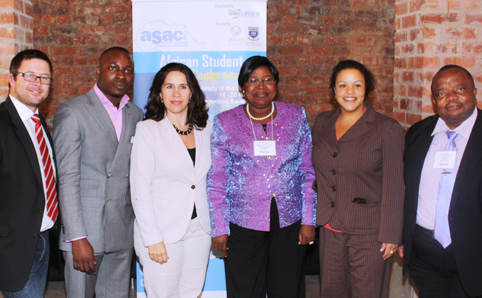 |
|
Mr Rudi Buys, UFS Dean of Student Affairs, Mr. Folabi Obembe, Managing Director of Worldview International, Ms Birgit Schreiber, Director of the Centre for Student support services at the University of the Western Cape, Dr. Augustinah Duyilemi, Dean of Student Affairs at the Adekunleh Ajasin University in Nigeria, Dr. Christina Lunceford, assistant Director for the Centre for Research on Educational Access and Leadership at California State University in America, and Prof. Cecil Bodibe, student affairs veteran and consultant.
Photo: Earl Coetzee
|
The African Student Affairs Conference (ASAC), which took place on our Main Campus last week, was a major success, with two days of lectures and discussions and two pleasant social gatherings, where delegates had the opportunity to get to know each other.
The conference, hosted on African soil for the first time, and co-hosted by the University of the Western Cape (UWC), started on Wednesday 18 May 2011 with an informal welcoming session. Delegates got to meet each other and Mr Rudi Buys, UFS Dean of Student Affairs, explained the meaning of South African words like "kuier" and "lekker'.
The official start of events took place on Thursday 19 May 2011, in the Reitz Hall in our Centenary Complex. The conference was attended by delegates from universities across the continent and aimed to place the focus on issues relating to student affairs in an African context.
Delegates shared and exchanged strategies, ideas and resources, and discussed issues related to the work of student affairs professionals. The conference hoped to promote an exchange of best practice and assist attendees in identifying successful programmes.
Among the topics discussed on the first day, were “Constructing Post-Conflict Democracy on campus: a case study of transformation of student governance and political engagement as post-conflict intervention”, by Mr. Buys, and a discussion on ways in which social and online media can be used to ease the challenges of student interaction, development and support, by Ms Birgit Schreiber, Director of the Centre for Student Support Services at UWC.
A panel discussion, led by Mr Buys and several members of our Interim Student Council (ISC), discussed the specific challenges faced at the UFS. The importance of buy-in from role-players in decisions taken by University management in order to ensure their success, was discussed, using the UFS and our recent changes as an example.
The successful integration of residences on campus inevitably came under the spotlight and the recently resolved Reitz-saga was named as a catalyst in getting students less apathetic and more involved in attempts at creating racial and social harmony.
Dr Christina Lunceford, Assistant-Director of the Centre for Research on Educational Access and Leadership at California State University, presented a paper entitled A National Approach to Building Capacity in Student Affairs in South African Higher Education.
She commented on the fact that there is little or no philosophical framework or explicit theory that informs practice of student services in South Africa.
According to Dr Lunceford, student development should be a key concern for every department or unit within student services and emphasized the need for a centralized student development unit at each university.
She also touched on the need for institutions to implement support from international student affairs professional associations, professional development for student affairs practitioners, the utilization of technology to support professionals in the field, and working with international partners to explore future opportunities, as ways in which student affairs can be used to drive performance and change at universities.
The conference continued in the Scaena theatre on Friday 20 May 2011, with presentations by Dr Augustinah Duyileme, Dean of Student Affairs at Adekunle Ajasin University in Nigeria, and Prof. Bobby Mandew, Executive Director of Student Affairs at the University of Johannesburg (UJ).
Dr Duyileme presented a paper on the challenges faced by Nigerian universities with regard to student conflict and protests, which often turn violent, and how such violence can be curbed through proper planning and management.
Prof. Mandew presented a very well-received presentation on UJ’s successful off-campus housing initiative, which involves home-owners and business owners in the areas surrounding their campuses.
Their approach demonstrated how proper planning can prevent problems associated with over-population in private homes and conflict with neighbours of the university, usually related to an influx of students into residential neighbourhoods.
This problem is faced by many universities, as more and more students flock to universities on the continent and campus residents cannot accommodate them.
The conference came to a close on Friday, with most delegates agreeing that the exchange of knowledge which took place was extremely valuable.
Ms Deborah Lahlan, of Nigeria, said: “This is an important conference for Africa and it should become a regular event.”